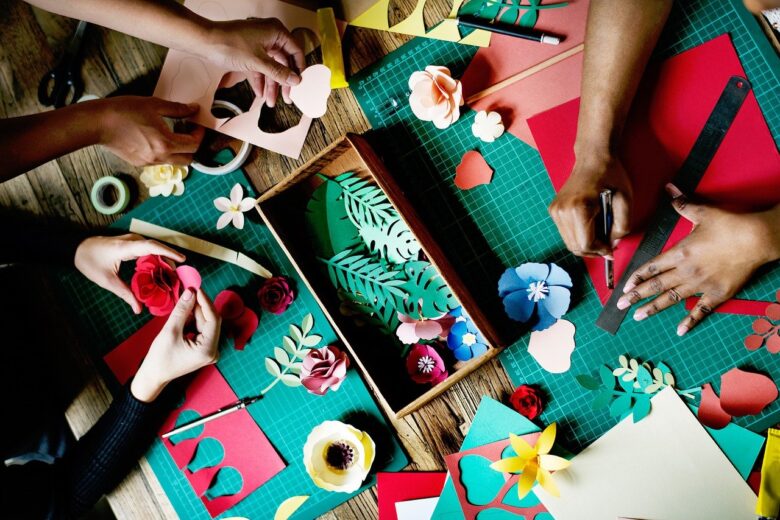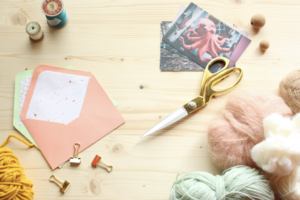Paper is easy to find and can be used for many different crafts. It has fascinated artists and enthusiasts for centuries. There are many creative ways to use paper crafts, from simple ones like origami to more complex ones like paper quilling. This article takes you on a magical journey into the magical world of paper, where simple pieces of paper can be transformed into beautiful works of art using various techniques.
1. Origami: The Art of Folding Paper
The ancient Japanese art of origami is a fascinating way to fold a flat piece of paper into complex three-dimensional shapes without the use of glue or cutting. Origami allows crafters of all levels to create many different things, from simple animals and flowers to complex geometric shapes.
If you want to learn to fold origami, start with simple shapes such as the valley fold and the mountain fold. As your skills improve, you can move on to more difficult projects, such as modular origami and tessellation. Because origami can be soothing, it is a great craft for those who want to get creative without losing their minds.
2. Paper Quilling: Use Rolled Strips to Create Interesting Designs
Quilling, also called ‘quilling paper’, is the art of rolling thin strips of paper into intricate patterns and shapes. These rolled shapes are then combined to create patterns, flowers or even highly detailed portraits. Because paper quilling requires patience and precision, it is an effortless and beautiful craft.
You will need a paper quilling tool, paper quilling strips of different colors and paper quilling boards to start paper quilling. To create your own design, try different shapes, such as spirals, curls and teardrops. With practice, crafters can transform their quilting projects into unique works of art.
3. Decoupage: Use Paper Collage to Change the Look of Surfaces
Decoupage is a method of decorating with paper in which layers of decoupage and paper are glued together to create a collage effect. This technology is very flexible and can be used on many surfaces, such as glass, ceramics, furniture and home furnishings. Through decoupage, craftsmen can give an old or plain object a new look.
To start a decoupage project, you will need to purchase images or patterns from magazines, decorative paper or tissue paper. Use a decoupage medium such as Mod Podge to adhere the decoupage to a surface of your choice. Try layering and overlapping to make your decoupage project look beautiful and unique.
4. Creating 3D Art from Rolled Strips of Paper is Called Paper Quilling
As we have already mentioned, paper quilling is the process of rolling strips of paper into intricate patterns. However, paper quilling is a more general term that refers to the use of strips of paper to create three-dimensional art. In addition to traditional quilting, this method also allows artisans to create sculptures, small scenes and even wearable art.
Combine the rolled strips to create shapes and structures and see what else you can do with quilled paper. This technique allows crafters to step outside the usual limitations of papermaking and transform simple strips into stunning three-dimensional works of art. They can make anything from jewelry to cute statues.
5. Pop-up Card: A More In-Depth Greeting
Making pop-up cards is a fun way to make paper that adds a little fun and surprise to a standard greeting. By strategically cutting and folding the paper, crafters can create intricate patterns that stand out when the card is opened. For special events, pop-up cards are great because they can add a personal touch to words of love, thanks or celebration.
Learn basic pop-up techniques, such as the V-fold or box fold, so you can make pop-up cards. With these tips and artistic images, you can create cards that are unique and stand out. Making pop-up cards is fun because the recipient will be surprised when they open the card.
6. Use Decoupage to Create Intricate Outlines and Designs:
Using scissors or a knife to cut intricate drawings or outlines from paper is an ancient art form called kirigami. By learning to cut paper with precision, crafters can use their imaginations to create everything from delicate lace patterns to large-scale modern designs.
To learn how to cut paper, start with simple patterns and work your way up to more complex patterns. Beginners can use templates and stencils as tools to help them improve their skills. Decoupage is a wonderful way to add a new dimension to papermaking. It can stand alone as a work of art or be used in a larger project.
7. Use Paper Machines to Create Strong Structures from Pulp:
You can make buildings of many different shapes and sizes from papier-mâché by stacking strips of paper or pulp dipped in a paste of flour and water. When dry, papier-mâché is a strong but lightweight material that can be shaped and painted to create many things, from piñatas to faces.
Start your papermaking project by gathering newspaper, flour, water and a mold or frame. Add several layers of pulp or paper strips and wait for each layer to dry before adding the next. If you want to show off your creativity, paint and decorate paper mache products once the structure is solid.
Conclusion:
With a simple piece of paper you can create intricate sculptures, bright collages and surprising pop-up cards. The world of paper production methods is filled with endless possibilities. Artisans can discover new skills, experiment with different styles and share their artistic vision with the world through each technique’s unique expression of creativity.
Whether you prefer the precision of paper cutting, the calming effect of origami or the tactile feel of papier-mâché, the magic of papermaking is creating something and seeing it come to life from a simple piece of paper . Get your art and craft materials ready, use your imagination and embark on a magical paper adventure that shows off who you are and your artistic spirit.
FAQs:
1. What are the basic tools and materials needed for a beginner interested in exploring papermaking techniques?
Beginners should start with basic tools such as scissors, a cutting mat, and an adhesive such as glue or Mod Podge. Depending on the technique chosen, specific materials are needed, such as quilt strips, origami or decoupage media.
2. Is paper making suitable for all levels? What technique is recommended for beginners?
Yes, papermaking is suitable for all skill levels. For beginners, origami is a great place to start because of its simplicity and low material requirements. As skills progress, artisans can explore more complex techniques, such as paper quilting or decoupage.
3. Can paper products be used for utilitarian purposes, or are they mainly decorative?
Paper products are both practical and decorative. While techniques such as origami and quilling typically result in decorative pieces, other techniques such as decoupage or papier-mâché can be used to create functional items such as furniture, masks and even piñatas.
4. Are there specific safety considerations when using certain papermaking techniques, such as decoupage or using self-adhesive products?
Yes, some techniques require sharp tools, such as craft knives, or the use of glue. Professionals must be careful and follow safety guidelines when using these tools. In addition, when working with certain adhesives, it is recommended to work in a well-ventilated area.
5. How do you personalize and personalize paper items so that they reflect your personal style and preferences?
Personalization can be achieved through the choice of colors, patterns and themes. Craftsmen can experiment with different types of paper, adding embellishments such as sequins or ties, or adding personal touches such as photos to make each project unique.


